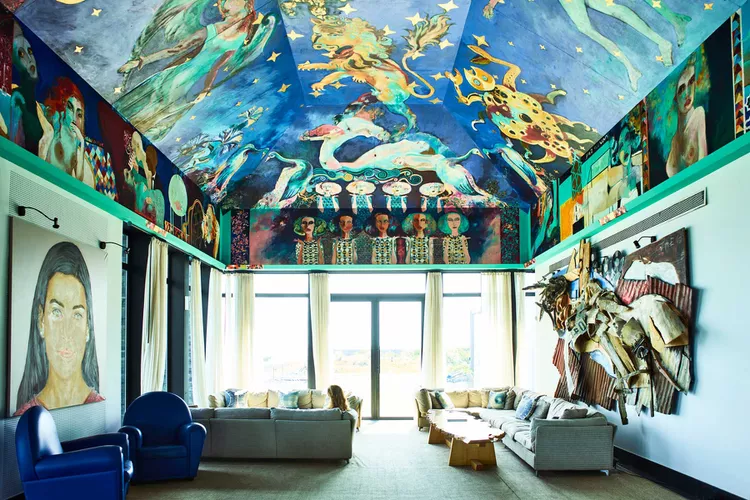As I breezed through the automated border checkpoint at Montevideo’s Carrasco Airport, shook a sincere hand with a rental car driver, crossed town in less than 30 minutes during rush hour, and ate a plate of barbecue at the Mercado del Puerto, I remembered why I’ve always loved coming to Uruguay. No country in the world is more mellow, humble, or pleasant – and no country’s meat is better.
It was early December 2019, and I was back in Uruguay for the first time in over a decade. I defended my meat-eating as a kind of litmus test. At a former produce market in Montevideo, has the menu changed for this group of parrillas (eateries specializing in steaks, sausages, and organ meats grilled over wood and charcoal)? Has the firm, working-class feel of the place become prissy and sophisticated? Of all my childhood memories of Uruguay, Barilla is a cornerstone.
Sitting at the counter, watching the tattoos on the arms and neck of the grilled chicken as it grilled the Bolovolo cheese on top, I got my answer. If the cows that used to graze are now a little fatter, everything else – from the delicious cappuccino to the dazzling caramelized milk pancakes – is exactly as I remember it.
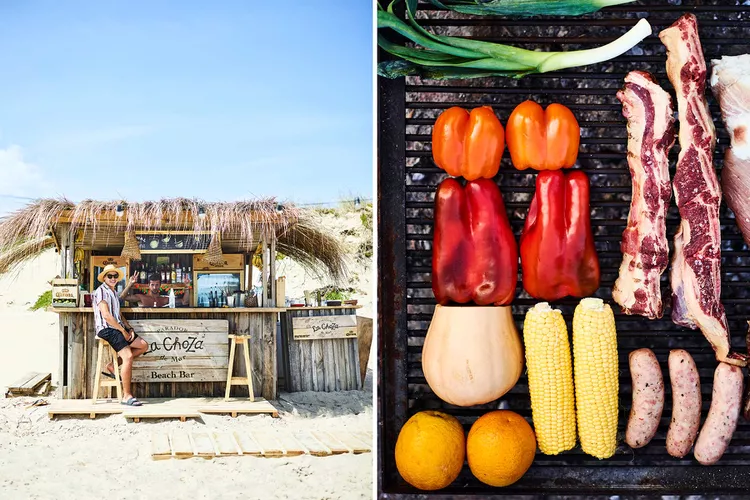
My grandparents fled Serbia during World War II and settled in the seaside community of Carrasco, Montevideo, Uruguay’s capital. Their children eventually dispersed to Argentina and the United States (our former home is now a branch of JPMorgan Chase Bank). But from childhood until my twenties, my family vacations were spent meeting relatives in Buenos Aires and then flying to the coastal town of Punta del Este in Uruguay. No need to stay in a hotel: El Grillo, my aunt’s blue-roofed white brick cottage, is a gathering place for beach excursions and evening walks along Gorlero Avenue, Punta del Este’s main street, in search of churros and ice cream.
As my siblings and I grew older, our family visits dwindled. In my aunt’s words, Punta del Este succumbed to overdevelopment and became “mini Miami.” My Cousins started renting beach villas farther along the coast in the province of Maldonado and next door in the quieter province of Rocha. Years passed — decades. In 2013, Uruguay’s government made world news for legalizing same-sex marriage and marijuana long before the United States. The country of 3.5 million people has quietly climbed to 14th place on the Happiness Planet Index, as it usually does. Suddenly, this breezy, relaxing beach – which I had always thought of as an unpretentious refuge for wealthy Argentines – reinvented itself as a glitzy global destination, with people now describing it as the “Riviera of Uruguay” and the “Saint Tropez of South America.”
When my cousin Michele, who still lives in Buenos Aires, suggested that we reunite in the region – not so much to find our roots as to investigate existing products – I found the idea irresistible. And so, a month later, we took a bittersweet drive through El Grillito (no longer part of the family), crossed the rolling Leonel Viera Bridge, and sped down coastal Route 10, Past undeveloped dunes and open beaches that I remember from childhood. The bridge separates Punta del Este from the more low-key towns to the east.
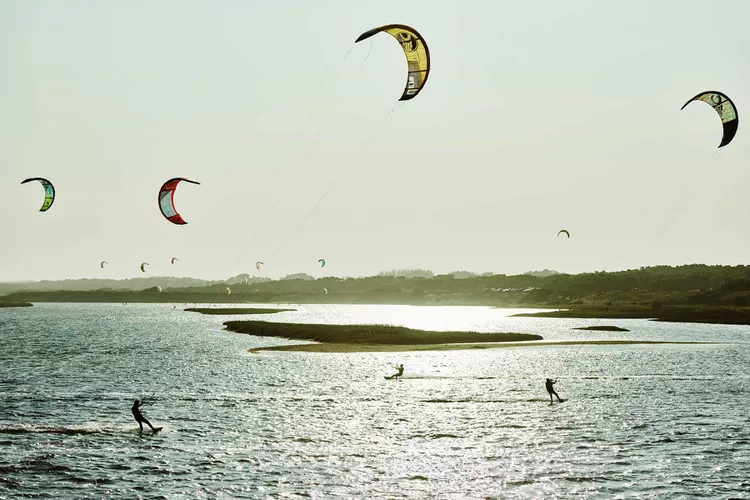
Arguably, the coolest of these towns is Jos Ignacio. This sleepy fishing village is now at the heart of Uruguay’s beach landscape. My cousin’s visit to the place was obviously private. She points to the houses she has rented over the years, “some with boyfriends, some without boyfriends,” and to the lighthouse on the tip of the rock that divides the town. There’s also a cobblestone beach, “where you can come in the morning and buy fish from fishermen.” Of course, she shrugs; with the arrival of pop stars, footballers, and supermodels, some tiny houses have been replaced by big ones. The town has become more lively, and the fashionable has replaced the shabby.
However, the place remained delightfully unspoiled. Almost every corner of the town has a corner, if not two, of the Atlantic Ocean. On one side is playa brava, meaning “rough beach,” facing the sea; On the other is playa mansa, which means “calm beach.” Both views areancy signage, or fancy architecture mar andither view. “Here, you walk to the beach, restaurants, and the square behind the beach and have coffee. You don’t need a car, “Michelle said.
My cousin laughed, dismissing comparisons to destinations like St-tropez and the Hamptons. “St. Tropez is crowded; there’s almost no sand,” she said. “The Hamptons are beautiful, but socially… ?” Her eyes narrowed. She estimates that the “Uruguay Riviera” has up to 15 hotels with a total capacity of 1,000 guests. “Uruguay,” she said, “you have beaches all the way up the coast.” The scene always stays calm with so much space and so few crowds.
Without a doubt, the most successful restaurant in the area is La Huella. It looks and feels like a houseboat, with thatched roofs, sand-dust-covered wooden deck floors, and a group of immaculate-looking, even-toned 20-something employees, and it’s probably the most well-planned, effortless simulation you’ll ever see. During the busy months of January and February, it is also the most challenging list to score.
My cousin was taken aback when Mahle Terry, wearing a polo shirt, seated us on the outer deck near the entrance. “It’s the best,” she whispered. “When they don’t want people to see you, they put you in the back.” We skipped the sushi and ordered the grilled squid (chipirones a la plancha), the mollejas, and the white coconut fish (cooked almost exclusively with salt, one of the best and purest fish dishes I’ve ever had).
My cousin breezed off a series of greetings—kisses, cheeks, “Ay, ququedivino!” I remember the intense social rituals of this still-small world from a young age. The sea, the beach, the children, and the strong dialects of Uruguay and Argentina all felt very familiar to me. What was new, at least for me, was the addition of voices speaking American and British English, Dutch, German, French, and Portuguese.
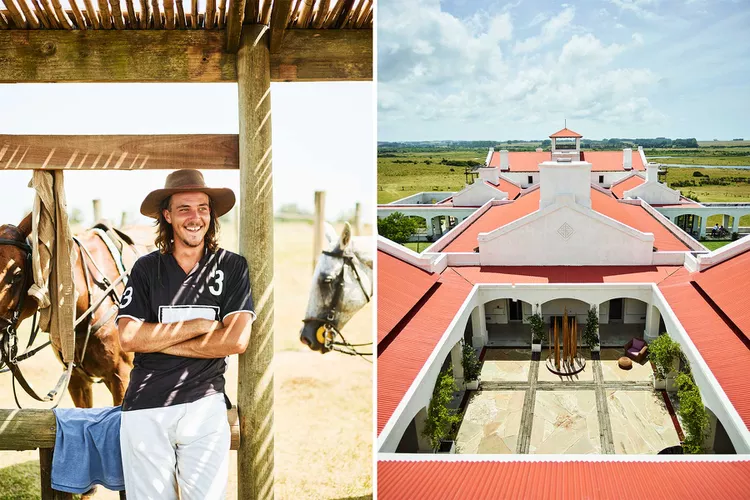
At first, Wick Manor seemed too quiet. The ranch is seven miles inland from Joss, Ignacio. It is one of three properties in Uruguay developed by Norwegian-Uruguayan billionaire, investor, and entrepreneur Alex Vik and his wife Carrie (the other two are Playa Vik and Bahia Vik, on the beach). The Viks are often considered the ones in the area known for their cosmopolitan Proms, so I had expected a glitzy version of the men’s ranch like La Huella. But when we arrived, there were only our cars in the driveway. A visit revealed a stately living room with dramatic kaleidoscopic murals on the walls and ceiling, A grand brick dining room with stunning views, A candlelit cellar with 5,000 bottles of wine, And a doodle grill. Stylish, luxurious, dignified – but there was no one around. What happened to all the visible action?
As Michelle and I settled into our airy, tall room, I began to take in the atmosphere of the ranch. A brown-yellow Carancha eagle stood guard on a wooden fence outside my French window. In the distance were a sloping green pasture, horses (tawny, tawny, maroon, sable), a meandering river, and black cows on the far bank. I cried about leaving the beach, but my cousin insisted that we explore the interior of Uruguay. “The country is so incredibly rural,” she said. “In some places, children still learn on horses. They tied their horses to posts.” “I had to get away from the beach-centric mindset of my childhood,” she says. “It’s surf and turf now.”
When I was 21, I dropped out of college and spent a few months working as a real cowboy on a ranch in Argentina, and I have fond memories of that time. I hadn’t ridden a horse in half my life, though, so when Vic’s staff urged me to take polo lessons, I said no. First, I reasoned that polo was a snob’s game. Second of all, I would have broken my pelvis. Most disturbing of all, I would undoubtedly make a fool of myself. Turns out I was wrong. The timeless thrill of man and ball (in partnership with a 1,300-pound beast) is intoxicating. I can’t remember the last time I was so completely immersed in something.
Later in the afternoon, we mounted again and entered a towering eucalyptus forest with chirping monk parakeets. The excursion was arranged by Lares, a tour company that specializes in arranging horseback rides to Uruguay’s inland rivers and pastures. Led by the owner, Paola Perelli, and Agustin Bueno, a Gaucho in his 20s, we mounted horses fitted with recados, traditional saddles, and comfortable lambskin padding.
The four of us trotted, ran, headed for the beach, splashed across a shallow lagoon, and went surfing. The wind was strong, and the sun was low. The rugged dunes that stretch for miles on either side are desolate and totally ours. After dark, we returned to the ranch with our hips loose from the ride and the ranch behind the hotel smelling of vanilla. When our eyes adjust, we see Orion, the Southern Cross, and the Milky Way, unaffected by light pollution. As time passed, the lure of surfing and turf became more and more apparent.
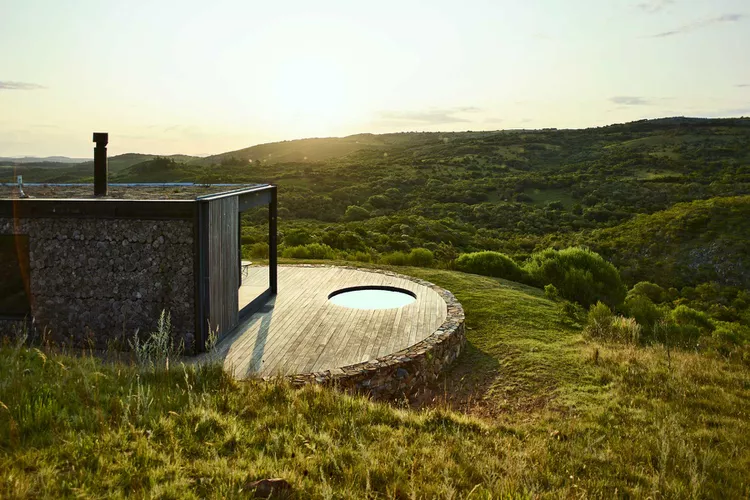
In the past, being inland in Uruguay meant sheep, cattle, and little else. In recent years, however, wealthy Argentines, Brazilians, quirky Uruguayans, and Americans have hired local and international architecture firms to build boxy, brutalist-style villas with panoramic views. Michelle and I passed a dozen of these estates, whitewashed, surprisingly unobtrusive, built with jagged boulders and natural wood, many still in use as farms.
By far the most notable of the new developments dominating Uruguay’s interior is the 400-acre, 580,000-gallon distillery Bodega Garzon, a sleek, state-of-the-art, $85 million enterprise; it was founded by Alejandro Bulgheroni, who is said to be the wealthiest man in Argentina. The winery offers Tours, and Argentine celebrity chef Francis Mallmann helms a restaurant. Bodega Garzon’s Tenants: It remains to be seen whether a big, delicious, spicy red wine similar to Malbecs), Pinot Grigios, Cabernets, and Albarinos will pave the way for Uruguay to join the ranks of export powerplants such as Argentina or Chile (2018, Uruguay’s exports grew to 6.5 million bottles, while Chile’s were 1.2 billion bottles). However, without more development, people now refer to the surrounding area as “the winemaking district of Garzon.”
Deeper in the province of Maldonado, rolling hills give way to rugged areas known as Uruguay’s Tuscany. We booked a stay at the Sacromonte Landscape Hotel, a beautifully designed “bunker” winery across from a sprawling vineyard near the village of Pueblo ed.
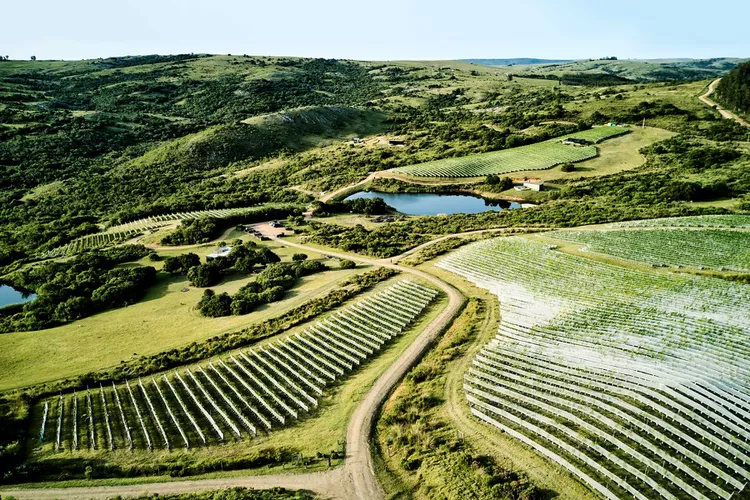
In 2014, Sacmont’s owner, Edmond Borit, left an executive position at a European multinational to follow in his grandfather’s footsteps, a French winemaker. He bought 250 acres of land for a specific purpose: to leave 85 percent uncultivated so the land could be restored to its natural state. “Everyone thinks I’m going through a midlife crisis,” he laughs. “I sold all my stock options, everything.”
With an almost profound artistic conviction, Borrit describes a mission dedicated to celebrating the land while preserving local traditions. He questions the outsize influence of the extensive vineyards down the road, which ironically talk about sustainability, saying, “I’m certainly interested in using the terroir here and making good wine.” But I’m also interested in getting people to think about this land, to construct nature for deeper thinking.”
Borit’s steel and reflective glass villas leave the typical Uruguayan beach and ranch paradigms far behind, unleashing the romance of its pastoral interior instead. Hiking through Sacromont’s private valley, I came to a clear, fast-flowing stream whose mossy rocks nestled between corridors of low willows and corona-short, prickly trees that kept out clouds of flying white moths.
Mr. Perrelli, the Lares guide, once pointed out that the pine forests and dense, fragrant eucalyptus forests that I had grown up unfailingly associating with the country were not native but were imported by Europeans to anchor dunes, produce building timber, and provide shade for cattle. In primitive times, Uruguay was covered by small, low-slung forests – like those regenerating in Sacmont. As I walked along the stream, playing peek-a-boo with a fox that ran ahead of me, the silence struck me most. The loudest sound I heard all morning was a cow mooing across the hill.
Watching the sunset that night over a bottle of Carap Reserva(an oak blend of Danna, Merlot, and Cabernet Sauvignon) with my cousin, I couldn’t help but see the little valley in front of me as a painting, a place of contemplation, outside of time and culture, for and for myself.
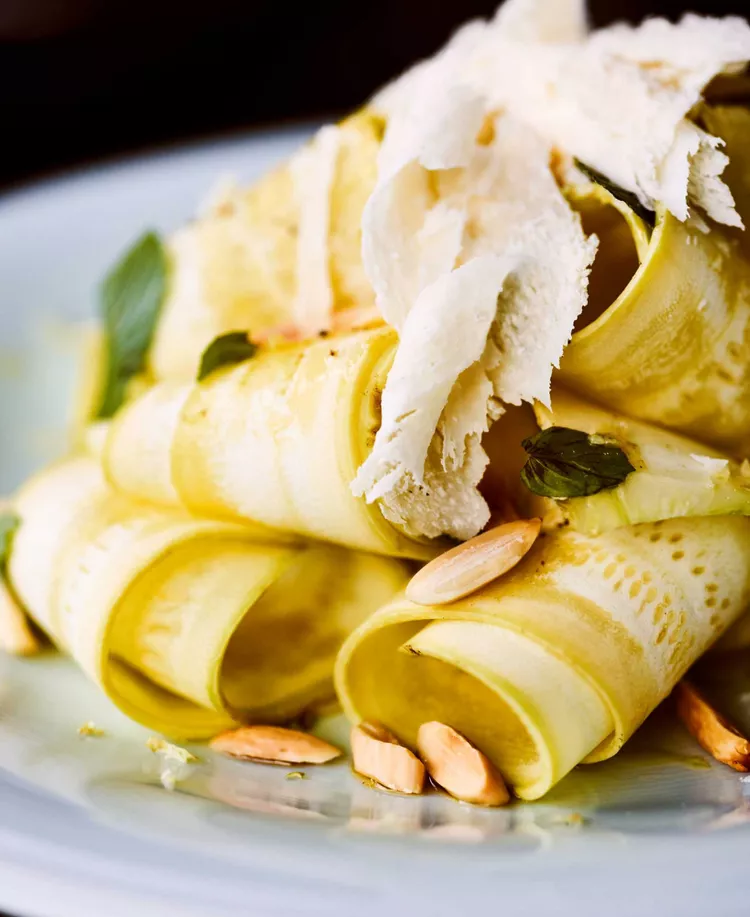
I circled back to Pueblo Garzon, about an hour’s drive from Sacro Monte. With a population of less than 300, the village seems an unlikely place for a culturally refined experience. The site lay dormant for nearly a century before being “rediscovered” by Malman and now boasts a hotel, two restaurants, and an artist’s residency. Malman’s hotel, restaurant Garzon and the adjoining bed and breakfast Casa Anna take classic Argentine and Uruguayan Deco design aesthetics and blend them with a warm, rustic French flair.
I ordered a Milanserin, a classic breadcrumb dish usually made with veal or beef. Wrapped in a mixture of pancakes, breadcrumbs, brioche, and Parmesan cheese, it was three to four times thicker than any I’d ever tasted, yet unusually tender. The grilled octopus with diced potatoes is smooth and unusual, looks computer-made, and is the perfect dish with salt and smoke (all Restaurant Garzon’s dishes are cooked over firewood). Raw zucchini salad with mint and broad slices of Parmesan is a world away.
Perrelli praised Malman as a visionary. “After February, all the other stores are closed, so what you see is outside the holiday window. Mallmann is open all year round, right here. He’s laying a deeper bet, “she continued. “He raised everyone’s level.”
For my last lunch, I chose Choto, a low-key new restaurant nearby run by Fabio Alberti, a beloved Argentine TV and film comedian. I parked on a grassy hill that looked more like a remote farmhouse than a restaurant. Alberti approached me kindly and mischievously and then apologized for my misfortune. His wife is visiting family in Argentina, so he has to cook. What he said was terrible.
Pointing to a makeshift chicken and cattle pen, a garden, a grove of FIG and peach trees, and a curious lamb who would accompany us through the meal, he shrugged and said, “Well, this is our trip.” Then he sat me under the vine-covered gazebo, disappeared into the house, and started playing Johnny Cash’s 1959 vinyl album Hymns.
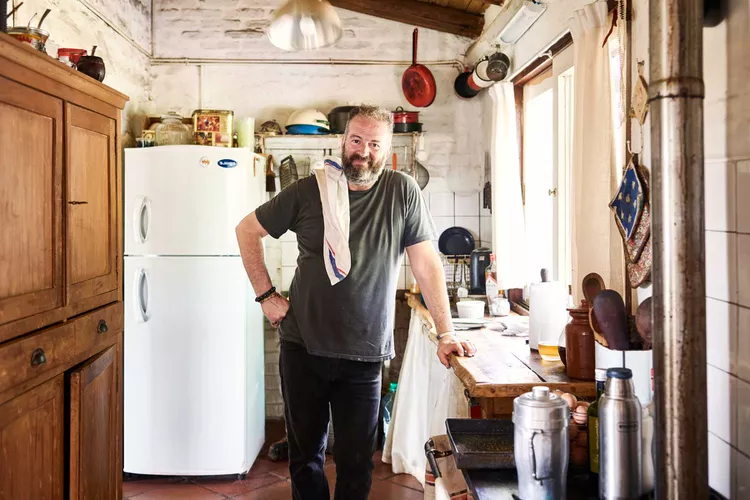
We shouted friendly through the kitchen window, and I learned that photo means intestine in Uruguay. However, in Argentina, the word has a much more vulgar meaning. When I asked Alberti what he thought of his restaurant, he didn’t hear me. A few minutes later, he came out of the kitchen with a large bone on a small plate.
“This,” he announced, “is the beef arm, similar to the beef knee.” We call it bone marrow caracu.” Served with flakes of sea salt the size of snowflakes on a rectangular piece of toast, the bone marrow is the equivalent of a tablespoon of food. This is extraordinary. Between plates of homemade blueberry head cheese, Alberti eats some gooey Camembert that he describes as “half Camembert, half Munster,” along with lettuce from the garden and a delicately poached egg. He explained that he had been coming to Pueblo Edwinheim occasionally for 15 years but only decided to move here from Buenos Aires a year ago. Even now, his transition into the restaurant business sounds tentative. “I’m not a cook; I’m an actor. I don’t want to be tied down here. When people want to come, well, I’ll open the door. If people like it, great.”
The last dish was duck—the first I had seen in Uruguay. The inside is tender and juicy, and the outside is fatty and crispy. Alberti served it with French fries and cooked it three times at different intervals. I said that he seemed to care a lot about cooking for a non-chef. He smiled. “I learned everything on YouTube.” Alberti’s carefully designed products starkly contrast with the pastoral, unpretentious setting, and it doesn’t get much more inviting.
To find Giotto, I took a dirt road with three forks and got out to manually open and close two fences. Alberti charges $42 per couple (including wine and dessert), almost as an afterthought. She has a busy Instagram account but is only concerned with other forms of advertising. I found his artistic talent inspiring and told him that his nonchalant attitude toward commerce reminded me of an imaginary, pure DJ offering free, ad-free shows on a remote island accessible only by canoe. Alberti seemed pleased with the comparison. “There’s nothing in Uruguay,” he mused. “But what it has, it uses perfectly. This is the way I want to live. I want to work less and have less, but use everything in the best way possible. I think that’s the perfect life.”
